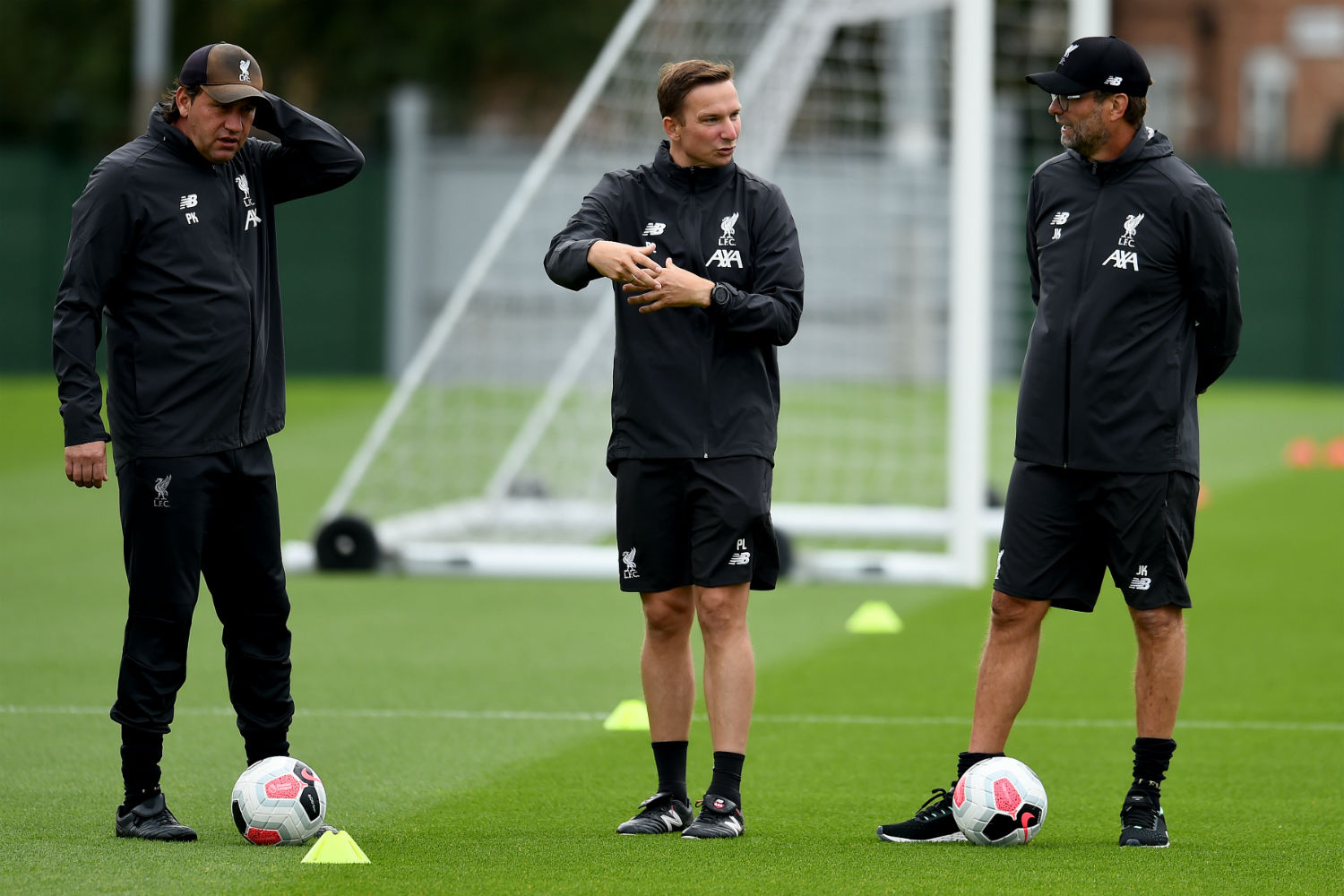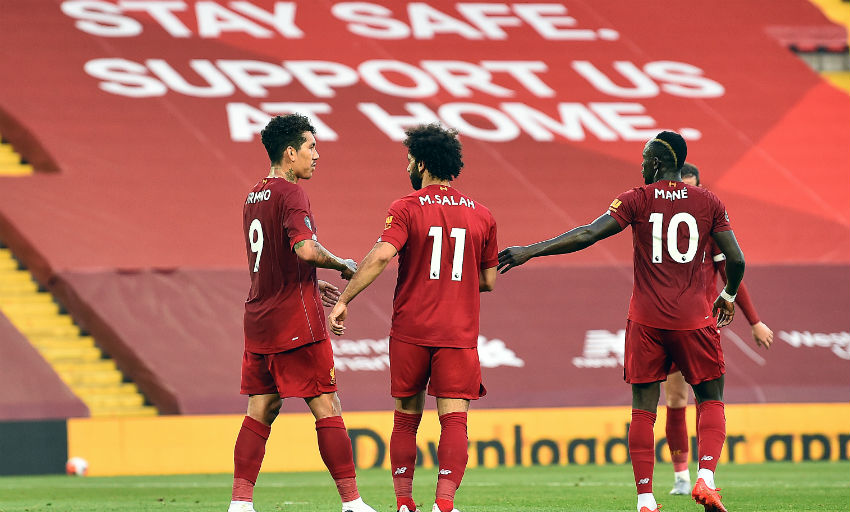In depth | The tactics that made Liverpool Premier League champions
To say it was the broadest smile that's crossed Jürgen Klopp's face during the past few weeks would be a very bold claim. But it was up there.
On a balmy Wednesday night towards the end of last month, Liverpool’s manager stood at the side of the Anfield pitch and waxed lyrical about his team’s performance against Crystal Palace.
He had every right to; in their first home game behind closed doors since the Premier League restart Liverpool had performed magnificently, scoring four goals - all glorious in totally different ways - starving their opponents of a single meaningful touch in the penalty area and moving to the cusp of an historic title win which would be sealed 24 hours later without another ball being kicked.
But it was something much more niche that thrilled Klopp; specifically a moment in the dying embers when Palace tried to manoeuvre the ball out of their own half in search of what would have been merely a consolation goal.
“That was the plan, that with the performance on the pitch we would show respect to the people [fans] who cannot be here today,” the boss stated.
“And we did that from the first second until the last - especially until the last, which is exceptional, when you are 4-0 up and [Jordan] Ayew gets the ball, and you have four players in a red shirt chasing like it’s the last ball on this planet.”
He would expand on the point in his press conference shortly afterwards.
“I said to the boys: ‘I want to see the best behind-closed-doors football ever.’ And I’m not sure if it was the best football, but it was for sure the best counter-pressing behind closed doors ever.”
When Klopp first arrived at Anfield five years ago the internet was awash with blogs explaining exactly what this strange new tactical innovation - also known as gegenpressing - was and why it had proved so successful during the former Mainz centre-forward’s time in charge of Borussia Dortmund.
As author and tactical analyst Michael Cox pointed out in a recent article for The Athletic titled ‘The 10 tactical innovations that transformed Klopp’s Liverpool into champions’, there were already signs that the Reds squad were embracing the new methodology - and the physical demands it entailed - after mere days on the training ground, when they held Tottenham Hotspur to a goalless draw on the new manager’s debut back in October 2015.
Since then, thanks not just to Klopp but to the meticulous, cerebral approach of his assistants Pepijn Lijnders and Peter Krawietz, Liverpool have been tactical chameleons, shapeshifting from one season to the next before opponents can get a handle on how to counteract them.
In 2017-18, following the arrival of Mohamed Salah, the Reds regularly rampaged from one end to the other faster than you could say ‘boom’, famously taking just 13 seconds to go from defending a corner to scoring through Salah away to West Ham United and netting after two rapid counter-thrusts at Brighton & Hove Albion.
Moving into the last campaign and the present one, that specific type of goal is more of a rarity, but has been more than adequately replaced by a raft of new attacking ‘plays’, including but not limited to: clever set-piece routines, long passes unerringly strafed in behind opposition defences, and the emergence of full-backs Andy Robertson and Trent Alexander-Arnold as auxiliary playmakers.
“They have evolved into such an all-round team, and it’s tough to know what their weakness is when you’re trying to set up against them defensively,” Cox tells Liverpoolfc.com. “You almost have to fear them in every area - the forwards, the full-backs, the danger of being overran in midfield.
“The really interesting thing is the crossing from full-back, because there was almost a sense that crossing was going out of the game at the top level. Liverpool have brought it back; not with a big No.9, but with strategy, pinpoint deliveries rather than whipping it in aimlessly, and you wonder if that will repopularise the concept now that they’ve made it work so well.
“People always talk about how frantic Klopp’s style is, but actually, I think it’s more controlled at Liverpool than it was at Dortmund. Klopp is so well-known for pressing and counter-pressing, but I think if you watched Liverpool for the first time midway through this season and you didn’t know his background, you wouldn’t necessarily say that pressing is the main thing about them, because they’re good at so many other things now.”

Pressing and counter-pressing nonetheless remain the foundation stones underpinning Liverpool’s style. It’s almost reassuring, in a way, that in an era when football tactics are seemingly becoming more esoteric than ever before, the reigning champions of England, Europe and the world are a team whose ethos is centred upon plain, old-fashioned hard work.
Like a band that’s found success with new material but still likes to play the old favourites during the encore, the Reds have again pressed ‘like crazy’ - to borrow a Klopp catchphrase - since the Premier League restart. And while it was one thing to do it against Palace, with the title not yet theirs, to continue doing it since then - with only pride and the setting of records to play for, up against opponents with much more urgent objectives like survival or European qualification in mind - is quite another.
Away to Brighton, what could have been an uncomfortable evening at the home of an in-form side battling to avoid the drop was transformed into something altogether different by the nuisance qualities of Naby Keita, whose possession regains high up the field led to Salah and Jordan Henderson both finding the net inside the first eight minutes. At home to Burnley, a significant proportion of the cavalcade of chances the champions created - against a team renowned for their defensive stubbornness - stemmed from interceptions in the opposition half.
It’s down in the ‘data mines’ that the full extent of Liverpool’s physical efforts, and how discomfiting they are for other teams, becomes evident. Off the back of last season’s club-record 97-point haul, the question of how that could possibly be topped was a vexed one. Whether that tally will be bettered depends on what happens against Chelsea and Newcastle United of course, but when it comes to the rankings that measure pressing, last year’s team has been left in this one’s dust already - several weeks ago, in fact.
To be clear, that means the numbers achieved in all of last term’s 38 games combined had, remarkably, already been eclipsed by matchday 33 of this campaign, the Aston Villa clash at Anfield.
As of right now, with 180 minutes of football still to be played, the Reds are top of the Premier League class for high turnovers (with 240, compared to 195 last season) and pressed sequences (644, compared to 556 last season). The average distance from their own goal that Liverpool’s open-play sequences start has also climbed, from 43.8 metres to 45.2 metres, and the amount of their high turnovers that lead to shots has leapt from 27 up to 51.
“Pressing is clearly becoming a more prevalent part of the game, with teams like Southampton under Ralph Hasenhuttl, Chelsea under Frank Lampard and Leicester City under Brendan Rodgers all adopting a high press, and Liverpool are at the very forefront of that,” observes Michael Reid, football data editor for Opta, part of Stats Perform.
“Liverpool’s pressing numbers were good last season - that’s partly why the team picked up 97 points. But to increase the amount of turnovers, pressed sequences and starting distance to the extent that they have is incredible. 644 pressed sequences is around 18 a game - or once every five minutes of play - that Liverpool are stopping the opposition from putting more than three passes together within 40m of their own goal. It’s tireless.
“When you couple it with the quality in Liverpool’s side, it’s clear why they won the league with seven games to spare this season. Having quality players is one thing, but for these players to then have the work ethic and desire to press high, force mistakes and turn over possession in dangerous areas makes them a nightmare to play against. It’s clearly a testament to Liverpool’s work on the training ground that the players are fit enough and good enough to do this.”
One of the truisms of pressing is that it only works when everyone does it, forward players included, and it’s intriguing that when discussing the success of Pep Guardiola’s Barcelona a few years ago, Lionel Messi’s willingness to roll up his sleeves and muck in was an aspect that had particular resonance with Klopp.
At this point it’s almost taken for granted how hard Liverpool’s front three work, but perhaps it shouldn’t be.

Mane comes fourth out of all the attackers in the league for tackles this season, with 43, while Roberto Firmino and him rank fourth and fifth respectively for recoveries. Meanwhile, the Brazil international is out on his own when it comes to winning possession in the final third - doing so 35 times this term - despite being joint-top with ex-teammate Danny Ings a few weeks ago, demonstrating that if anything his work-rate has increased since the title was sealed.
No-one is suggesting Liverpool invented pressing and counter-pressing - Klopp freely acknowledges the influence of thinkers like Arrigo Sacchi and his former mentor at Mainz, Wolfgang Frank - or that they’re the only Premier League side that does these things, but it seems clear that their way of doing them is uniquely effective at this juncture. Why?
“In England we still talk about pressing as if its main component is physical energy,” continues Cox, who wrote extensively about Klopp’s work at Dortmund in his book Zonal Marking: The Making of Modern European Football.
“Whereas in Germany, where they’re obviously quite big on it, they would insist that it’s more of a positional thing. It’s more about strategy than energy, about getting into the right positions and making the right runs, and I think some of the managers who have tried to replicate how Klopp does it just haven’t thought about it quite so strategically.
“The funny thing about Klopp is that a lot of Premier League teams already tried to copy his Dortmund pressing style before he even came to England, so he arrived after his ideas did in a sense.”




